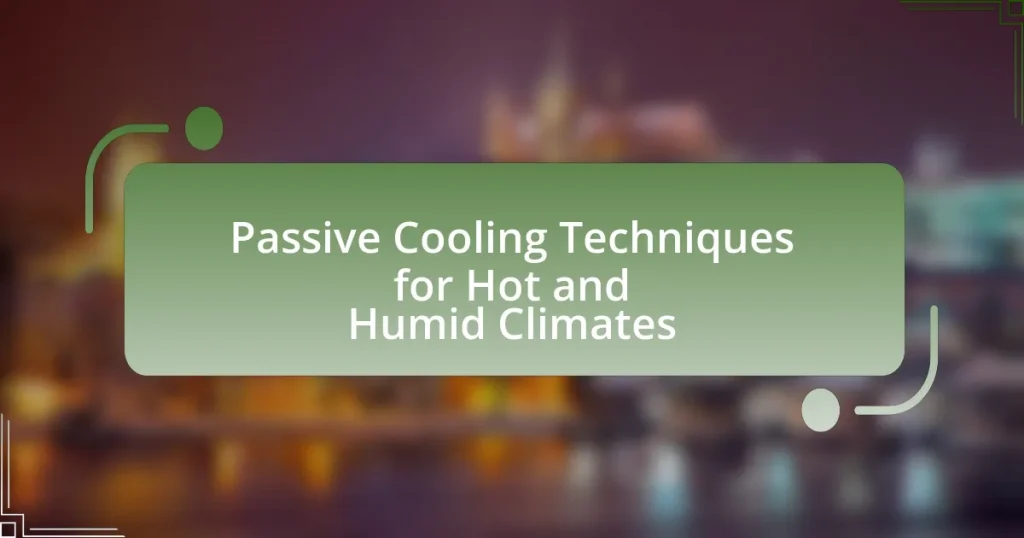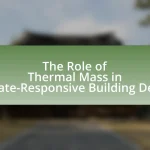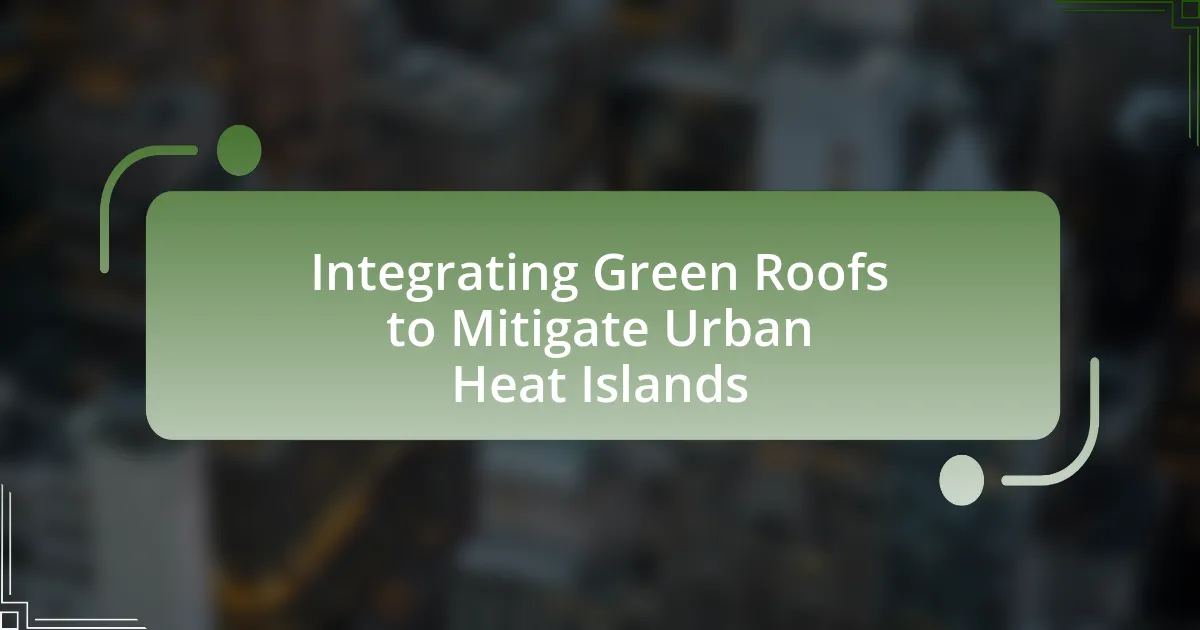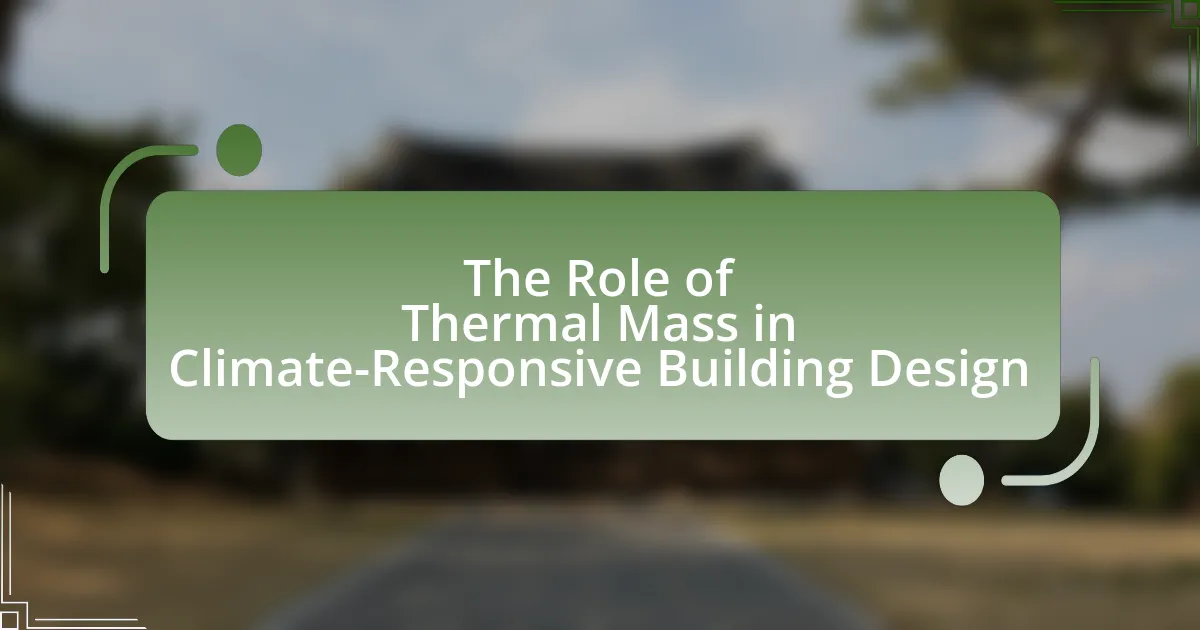Passive cooling techniques are strategies designed to reduce indoor temperatures in hot and humid climates without relying on mechanical cooling systems. These methods utilize natural processes such as ventilation, shading, and thermal mass to enhance indoor comfort and significantly lower energy consumption. Key principles include natural ventilation through airflow, the use of materials with high thermal mass to stabilize temperatures, and shading devices to minimize heat gain. The article explores the effectiveness of these techniques, their differences from active cooling methods, and the benefits they offer, including improved air quality and reduced energy costs. Additionally, it addresses challenges and misconceptions associated with passive cooling, providing insights into best practices for implementation and retrofitting existing buildings.

What are Passive Cooling Techniques for Hot and Humid Climates?
Passive cooling techniques for hot and humid climates include strategies that reduce indoor temperatures without mechanical cooling systems. These techniques leverage natural processes such as ventilation, shading, and thermal mass to maintain comfort. For instance, cross-ventilation utilizes prevailing winds to cool spaces, while shading devices like awnings and overhangs block direct sunlight, reducing heat gain. Additionally, materials with high thermal mass, such as concrete or brick, absorb heat during the day and release it at night, stabilizing indoor temperatures. Studies have shown that implementing these techniques can significantly lower energy consumption and improve indoor comfort levels in hot and humid environments.
How do Passive Cooling Techniques differ from Active Cooling Methods?
Passive cooling techniques utilize natural processes to reduce indoor temperatures without mechanical systems, while active cooling methods rely on energy-consuming equipment like air conditioners. Passive cooling includes strategies such as natural ventilation, thermal mass, and shading, which leverage environmental factors to maintain comfort. In contrast, active cooling methods require electricity to operate, often resulting in higher energy consumption and operational costs. For example, according to the U.S. Department of Energy, passive cooling can reduce energy use by up to 50% compared to traditional air conditioning systems, demonstrating the efficiency and sustainability of passive approaches.
What are the key principles behind Passive Cooling Techniques?
The key principles behind Passive Cooling Techniques include natural ventilation, thermal mass, shading, and insulation. Natural ventilation utilizes airflow to cool indoor spaces, often achieved through strategically placed windows and vents that promote cross-ventilation. Thermal mass involves using materials that absorb heat during the day and release it at night, helping to stabilize indoor temperatures. Shading techniques, such as overhangs or vegetation, reduce direct sunlight exposure, thereby lowering heat gain. Insulation minimizes heat transfer between the interior and exterior, maintaining cooler indoor conditions. These principles are supported by studies indicating that buildings designed with these techniques can reduce energy consumption significantly, enhancing comfort in hot and humid climates.
Why are Passive Cooling Techniques particularly effective in hot and humid climates?
Passive cooling techniques are particularly effective in hot and humid climates because they leverage natural processes to reduce indoor temperatures without mechanical systems. These techniques, such as cross-ventilation, shading, and thermal mass, enhance airflow and minimize heat gain, which is crucial in environments where high humidity can make heat feel more oppressive. For instance, cross-ventilation allows cooler breezes to flow through buildings, effectively lowering indoor temperatures, while shading prevents direct sunlight from heating surfaces. Studies have shown that buildings designed with passive cooling strategies can achieve temperature reductions of up to 10 degrees Celsius compared to conventional designs, making them highly efficient in maintaining comfort in hot and humid conditions.
What are the main types of Passive Cooling Techniques?
The main types of passive cooling techniques include natural ventilation, thermal mass, shading, and evaporative cooling. Natural ventilation utilizes airflow to cool indoor spaces, often achieved through strategically placed windows and vents. Thermal mass involves materials that absorb and store heat, releasing it slowly to maintain comfortable temperatures. Shading techniques, such as overhangs and awnings, reduce direct sunlight exposure, thereby lowering indoor temperatures. Evaporative cooling leverages the natural process of water evaporation to cool air, effectively reducing heat in hot and humid climates. These techniques are validated by studies showing their effectiveness in reducing energy consumption and improving indoor comfort in warm environments.
How does natural ventilation contribute to passive cooling?
Natural ventilation contributes to passive cooling by facilitating the movement of outdoor air into indoor spaces, thereby reducing indoor temperatures without mechanical systems. This process relies on temperature differences and wind pressure to create airflow, which helps to dissipate heat accumulated in buildings. Studies indicate that effective natural ventilation can lower indoor temperatures by as much as 5 to 10 degrees Celsius compared to non-ventilated spaces, enhancing thermal comfort and reducing reliance on air conditioning systems.
What role do thermal mass and insulation play in passive cooling?
Thermal mass and insulation are critical components in passive cooling, as they help regulate indoor temperatures by absorbing, storing, and releasing heat. Thermal mass materials, such as concrete or stone, absorb heat during the day and release it at night, thereby reducing temperature fluctuations and maintaining a more stable indoor climate. Insulation, on the other hand, minimizes heat transfer between the interior and exterior, preventing unwanted heat gain during hot days and retaining cooler air inside. Studies have shown that buildings with high thermal mass and effective insulation can achieve significant energy savings, with reductions in cooling energy use by up to 30% in hot and humid climates.
How can shading and landscaping enhance passive cooling effects?
Shading and landscaping can significantly enhance passive cooling effects by reducing solar heat gain and increasing evaporative cooling. Trees, shrubs, and other vegetation provide shade, which lowers surface temperatures of buildings and outdoor areas, thereby minimizing the need for mechanical cooling. For instance, strategically placed trees can block direct sunlight from hitting walls and windows, reducing indoor temperatures by up to 20 degrees Fahrenheit. Additionally, landscaping elements like water features and green roofs can promote evaporative cooling, further lowering ambient temperatures. Studies have shown that urban areas with increased greenery can experience temperature reductions of 2 to 5 degrees Celsius compared to those with minimal vegetation, demonstrating the effectiveness of these techniques in hot and humid climates.
What are the benefits of implementing Passive Cooling Techniques?
Implementing passive cooling techniques offers significant benefits, including reduced energy consumption and improved indoor comfort. These techniques leverage natural ventilation, thermal mass, and shading to maintain comfortable temperatures without relying on mechanical cooling systems. For instance, studies show that buildings designed with passive cooling can reduce energy use by up to 50% compared to conventional air conditioning methods. Additionally, passive cooling enhances air quality by promoting fresh air circulation, which is crucial in hot and humid climates where humidity levels can lead to discomfort and health issues.
How do Passive Cooling Techniques impact energy consumption?
Passive cooling techniques significantly reduce energy consumption by minimizing the need for mechanical cooling systems. These techniques, such as natural ventilation, thermal mass, and shading, leverage environmental factors to maintain comfortable indoor temperatures. For instance, studies show that buildings utilizing passive cooling can achieve energy savings of up to 50% compared to those relying solely on air conditioning. This reduction in energy demand not only lowers utility costs but also decreases greenhouse gas emissions, contributing to a more sustainable built environment.
What health benefits can be associated with Passive Cooling Techniques?
Passive cooling techniques can significantly enhance health by reducing heat-related illnesses and improving indoor air quality. These methods, such as natural ventilation and thermal mass, help maintain comfortable indoor temperatures, thereby minimizing the risk of heat stress, dehydration, and heat exhaustion. Research indicates that environments utilizing passive cooling can lower the incidence of respiratory issues by promoting better air circulation and reducing reliance on mechanical cooling systems, which often circulate dust and allergens. Additionally, studies show that maintaining cooler indoor temperatures can improve sleep quality and overall well-being, as excessive heat is linked to sleep disturbances.
How can Passive Cooling Techniques be integrated into building design?
Passive cooling techniques can be integrated into building design by utilizing architectural features that enhance natural ventilation, shading, and thermal mass. For instance, strategically placed windows and vents can facilitate cross-ventilation, allowing cooler air to flow through the building while expelling warmer air. Additionally, overhangs and awnings can provide shade, reducing solar heat gain during peak sunlight hours. Incorporating materials with high thermal mass, such as concrete or brick, can help absorb heat during the day and release it at night, stabilizing indoor temperatures. Studies have shown that buildings designed with these passive cooling strategies can reduce energy consumption by up to 30%, demonstrating their effectiveness in hot and humid climates.
What design strategies maximize the effectiveness of Passive Cooling Techniques?
Design strategies that maximize the effectiveness of passive cooling techniques include optimizing building orientation, utilizing thermal mass, incorporating natural ventilation, and employing shading devices. Optimizing building orientation ensures that windows and walls are positioned to minimize direct sunlight exposure, thereby reducing heat gain. Utilizing thermal mass, such as concrete or brick, helps absorb heat during the day and release it at night, stabilizing indoor temperatures. Incorporating natural ventilation through strategically placed openings allows for cross-ventilation, enhancing airflow and cooling. Employing shading devices, like overhangs or awnings, blocks direct sunlight while allowing natural light to enter, further reducing indoor temperatures. These strategies collectively enhance the performance of passive cooling systems, making them more effective in hot and humid climates.
How can existing buildings be retrofitted for passive cooling?
Existing buildings can be retrofitted for passive cooling by implementing strategies such as enhancing insulation, installing reflective roofing, and optimizing window placement for cross-ventilation. Enhancing insulation reduces heat gain, while reflective roofing materials can lower indoor temperatures by reflecting sunlight. Additionally, strategically placed windows can facilitate airflow, allowing cooler outdoor air to enter and hot air to escape, which is crucial in hot and humid climates. Studies indicate that these retrofitting measures can significantly decrease energy consumption for cooling, with some buildings achieving up to a 50% reduction in energy use after such upgrades.

What challenges are associated with Passive Cooling Techniques?
Passive cooling techniques face several challenges, including climate dependency, design complexity, and maintenance requirements. These techniques rely heavily on local climate conditions, making them less effective in areas with high humidity or extreme temperatures. Additionally, the design of passive cooling systems can be intricate, requiring careful integration with architectural elements to ensure optimal performance. Maintenance can also pose a challenge, as systems like natural ventilation and shading devices may require regular upkeep to function effectively. These factors can limit the widespread adoption and effectiveness of passive cooling strategies in hot and humid climates.
What limitations do Passive Cooling Techniques have in certain climates?
Passive cooling techniques face significant limitations in hot and humid climates due to high humidity levels that hinder effective heat dissipation. In such environments, the moisture in the air reduces the efficiency of evaporative cooling methods, as the air is already saturated with water vapor, making it difficult for moisture to evaporate from surfaces. Additionally, passive cooling strategies like natural ventilation can be less effective when outdoor temperatures are similar to or exceed indoor temperatures, leading to discomfort and inadequate cooling. Studies indicate that in regions with high humidity, the reliance on passive cooling can result in increased indoor temperatures, which may necessitate supplemental mechanical cooling systems to maintain comfort levels.
How can humidity levels affect the performance of Passive Cooling Techniques?
Humidity levels significantly impact the performance of passive cooling techniques by influencing the effectiveness of evaporative cooling and thermal comfort. High humidity reduces the rate of evaporation, which is crucial for cooling methods that rely on moisture evaporation from surfaces or materials. For instance, in humid environments, the cooling potential of water features or vegetation is diminished because the air is already saturated with moisture, leading to less effective heat dissipation. Studies have shown that in regions with high humidity, the perceived temperature can be higher than the actual temperature due to the body’s reduced ability to cool itself through sweat evaporation, thereby making passive cooling strategies less effective.
What are common misconceptions about Passive Cooling Techniques?
Common misconceptions about passive cooling techniques include the belief that they are ineffective in hot and humid climates, that they require no maintenance, and that they can fully replace mechanical cooling systems. Research indicates that passive cooling can significantly reduce indoor temperatures and improve comfort levels by utilizing natural ventilation, thermal mass, and shading strategies, even in challenging climates. Additionally, while passive systems generally require less maintenance than mechanical systems, they still need periodic checks to ensure optimal performance. Lastly, passive cooling techniques are most effective when used in conjunction with mechanical systems, rather than as a complete replacement, as they can enhance overall energy efficiency and comfort.
How can these challenges be addressed?
To address the challenges of passive cooling techniques in hot and humid climates, implementing design strategies that enhance natural ventilation and thermal mass is essential. For instance, incorporating features such as cross-ventilation, shading devices, and reflective materials can significantly reduce indoor temperatures. Research indicates that buildings designed with proper orientation and ventilation can lower energy consumption by up to 30% in such climates. Additionally, utilizing local materials that have high thermal mass can help in absorbing heat during the day and releasing it at night, further stabilizing indoor temperatures.
What innovative solutions exist to enhance Passive Cooling Techniques?
Innovative solutions to enhance passive cooling techniques include the use of phase change materials (PCMs), green roofs, and advanced shading devices. Phase change materials absorb and release thermal energy, helping to regulate indoor temperatures by maintaining a stable environment. Green roofs provide insulation and reduce heat absorption, while also promoting evapotranspiration, which cools the surrounding air. Advanced shading devices, such as dynamic facades and overhangs, can effectively block direct sunlight while allowing natural light to enter, thus reducing the need for mechanical cooling. These solutions have been validated through various studies, demonstrating their effectiveness in reducing energy consumption and improving indoor comfort in hot and humid climates.
How can technology support Passive Cooling in modern architecture?
Technology can support passive cooling in modern architecture by integrating advanced materials and systems that enhance natural ventilation and thermal comfort. For instance, smart building technologies utilize sensors and automated controls to optimize airflow and temperature regulation, reducing reliance on mechanical cooling systems. Additionally, reflective materials and green roofs can lower heat absorption, while software simulations can model airflow patterns to design spaces that maximize passive cooling efficiency. These technological advancements are validated by studies showing that buildings employing such strategies can achieve energy savings of up to 30% compared to conventional designs.

What are best practices for implementing Passive Cooling Techniques?
Best practices for implementing passive cooling techniques include maximizing natural ventilation, utilizing thermal mass, and incorporating shading elements. Natural ventilation can be achieved by strategically placing windows and vents to promote airflow, which helps reduce indoor temperatures. Thermal mass, such as concrete or brick, absorbs heat during the day and releases it at night, stabilizing indoor temperatures. Shading elements like overhangs, awnings, or vegetation can block direct sunlight, further minimizing heat gain. These methods are supported by studies indicating that buildings designed with passive cooling strategies can reduce energy consumption by up to 50% compared to conventional designs, demonstrating their effectiveness in hot and humid climates.
What steps should be taken to assess a building’s suitability for Passive Cooling?
To assess a building’s suitability for Passive Cooling, one must evaluate its orientation, design, and materials. First, analyze the building’s orientation to maximize natural ventilation and minimize direct sunlight exposure, as buildings facing prevailing winds can enhance airflow. Next, examine the architectural design, ensuring features like overhangs, shading devices, and operable windows are present to facilitate passive cooling strategies. Additionally, assess the materials used in construction; materials with high thermal mass can absorb heat during the day and release it at night, aiding in temperature regulation. Finally, consider the surrounding landscape, as vegetation can provide shade and influence microclimates, further enhancing passive cooling effectiveness.
How can site analysis inform the application of Passive Cooling Techniques?
Site analysis can inform the application of passive cooling techniques by identifying specific environmental factors such as sun orientation, wind patterns, and vegetation that influence thermal comfort. For instance, understanding the sun’s path allows for strategic placement of shading elements, while analyzing prevailing winds can guide the design of openings for natural ventilation. Research indicates that buildings designed with site-specific data can achieve up to 30% energy savings compared to those that do not consider these factors, demonstrating the effectiveness of tailored passive cooling strategies.
What factors should be considered when selecting materials for passive cooling?
When selecting materials for passive cooling, thermal mass, insulation properties, reflectivity, and moisture resistance are critical factors. Thermal mass refers to a material’s ability to absorb and store heat, which can help regulate indoor temperatures by releasing stored heat during cooler periods. Insulation properties determine how well a material can resist heat transfer, impacting the overall energy efficiency of a building. Reflectivity, or albedo, affects how much solar radiation a material reflects versus absorbs, influencing surface temperatures and indoor comfort. Lastly, moisture resistance is essential in hot and humid climates to prevent mold growth and maintain indoor air quality. These factors collectively ensure effective passive cooling, enhancing comfort and energy efficiency in buildings.
What practical tips can enhance the effectiveness of Passive Cooling Techniques?
To enhance the effectiveness of passive cooling techniques, implement strategies such as maximizing natural ventilation, utilizing thermal mass, and incorporating shading devices. Maximizing natural ventilation involves strategically placing windows and vents to promote airflow, which can reduce indoor temperatures by up to 5 degrees Celsius. Utilizing thermal mass, such as concrete or brick, helps absorb heat during the day and release it at night, stabilizing indoor temperatures. Incorporating shading devices like awnings or pergolas can block direct sunlight, reducing heat gain by approximately 30%. These methods collectively improve indoor comfort and energy efficiency in hot and humid climates.
How can homeowners optimize their living spaces for passive cooling?
Homeowners can optimize their living spaces for passive cooling by implementing strategies such as maximizing natural ventilation, using thermal mass, and incorporating shading techniques. Maximizing natural ventilation involves strategically placing windows and vents to facilitate airflow, which can reduce indoor temperatures by up to 10 degrees Fahrenheit. Utilizing thermal mass, such as concrete or brick, helps absorb heat during the day and release it at night, maintaining a stable indoor climate. Additionally, incorporating shading techniques, like awnings or planting trees, can block direct sunlight, further lowering indoor temperatures and enhancing comfort. These methods collectively contribute to a more energy-efficient and comfortable living environment.
What maintenance practices are essential for sustaining passive cooling systems?
Essential maintenance practices for sustaining passive cooling systems include regular inspection and cleaning of ventilation pathways, ensuring unobstructed airflow, and maintaining the integrity of thermal mass materials. Regular inspections help identify blockages or damage that could impede airflow, while cleaning removes dust and debris that can reduce efficiency. Additionally, checking and repairing any cracks or deterioration in thermal mass materials ensures optimal heat absorption and release, which is crucial for effective passive cooling. These practices are supported by studies indicating that well-maintained passive cooling systems can improve indoor thermal comfort and reduce energy consumption significantly.




